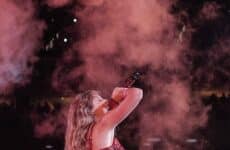By: Jacob Belham | Contributing Writer
I’d like to preface this editorial by emphasizing the importance of an event like the Expressions for Empowerment. The production accurately encapsulated the struggle of contemporary women, as well as portraying its subject matter in a both visceral and graceful way. I left the Casino Theater feeling profoundly inspired, but, unfortunately, not before feeling immensely frightened.
As we all filed into the theater, we were handed playbills listing the different acts and the names of their performers. I went to my seat and began to look through the bill. On the very front towards the top, the first piece was listed titled, “This is not a drill.” This is certainly not a comforting statement, but I didn’t think much of it at the time, so I glanced through the rest of the acts and put the bill down. If I had looked closer, I might’ve seen that the Active Shooter Booklet from the US Homeland Security was listed under the Works Referenced for “This is not a drill.” I didn’t see this clue, however, which stands to reason that many others in the audience missed it as well. Furthermore, while this may be a clue to the subject matter of the performance, it is in no way a full warning of the piece’s exact nature. Nowhere else on the playbill indicated any additional kind of trigger-warning.
When the show began, the lights went down, and the audience was informed of the locations of the exits in the “unlikely case of an emergency.” Theaters are mandated by law to inform their audience of the locations of emergency exits, so once again, I thought nothing of it, but to have this warning come before what happened next seems far from coincidental in retrospect. The act appeared normal enough when it began. Women danced around chairs in what I now realize must have been a classroom setting. I think It’s important to understand that at this time the theater was completely engulfed in darkness, except for the stage. With no warning, the house lights came up and a woman stood up from the audience. She blew a jarringly loud whistle and began to shout the warning, “Lock down, active shooter nearby.” The dancers had stopped dancing and looked as stunned as the audience. The woman continued to repeat that there was an active shooter as she walked towards the front of the house. I felt my heart leap to my throat. My body tensed, and my hands clutched the armrests of my chair. Suffice it to say, I was terrified. A strong part of me wanted to get up and run, and I probably would have had the woman shouting the warning not gone up on stage, and the dancers not started dancing again. I slowly realized this event was a part of the act, but the feeling of fear lingered well into the following piece.
The rest of the show proceeded, and my prior feeling of fear slowly turned to awe for the next performances. I would’ve liked my main takeaway from that night to be the inspiration instilled by the excellent performers, but instead I walked away feeling like I had witnessed a gross irresponsibility; this being in both the manner of the first performance, and how it affected the rest of the show. I feel it necessary to acknowledge the fact that an act like this could have caused a panic, which could have led to someone getting seriously injured. There was a variety of individuals in the audience that night, including both students and the elderly. It seems like the well-being of the audience was disregarded for the payoff of a scare.
Following the event, I spoke to some other individuals who had been in the audience that night. Junior Danny Landino, a member of Salve’s Theater Program, made the following statement, “I think they crossed the line between artistic expression and pure shock value. I understand what their intention was, but it was without warning, and for the piece to be called ‘This is not a drill,’ I think it was certainly careless to a degree. Again, I understand that this wasn’t their point or prerogative, but I think it could have been handled better than simply screaming “active shooter” in a crowded theater with no warning. On the whole, the event was great. It had a lot of good things to say. But to have that be the kick off however, made me scared and distracted for the rest of the production.”
I also spoke to Junior Maddie Archer, who had actually been warned of the active shooter stunt by a friend prior to the show, “We knew it was coming because [a friend] had said they were going to do that prior, but I understand how others might have reacted. If I hadn’t known it was coming, I would have been frightened as well. When the lights came on, I was still frightened. I think if they had had a warning at the beginning of the show it would have been acceptable. Other than that, I really enjoyed it. I thought it was very moving.”
I found it crucial to give the performers of the piece a chance to respond to the sentiments expressed by individuals like Mr. Landino and Ms. Archer. I had the chance to speak with the director of the Salve dance program Lindsay Guarino, who began by clarifying that the performance depicted an active shooter drill rather than an active shooter situation. Ms. Guarino articulated how the normative nature of an active shooter drill should be taking center stage in conversation, “In dance you cannot separate the human aspect from the art, so we hope audience members see the work and have an aesthetic response that motivates them to reflect, discuss, experience empathy and carry their experience outward feeling empowered to make changes.” Ms. Guarino also expressed that this is a personal topic for some of the dancers who are currently education majors, “This is their reality as student teachers.” On a broader scale, Ms. Guarino finds it concerning how desensitized our nation has become with regards to mass shootings. She cited the fact that our country has witnessed three mass shootings in the past two weeks, and that her own children now find active shooter drills fun because they feel like a game. She hopes that this particular piece will provoke discussion, but that the message of the entire event won’t be lost in the focus of the first performance, “Expressions for Empowerment was one of the most moving theatrical experiences I’ve ever had. I’m grateful for the many brave students from dance, poetry, music, and theatre for making themselves vulnerable on the Casino Theatre stage. I was inspired by their authenticity and the power of their truths. Art should make us feel more alive, more human. These students and this collaborative event did exactly that.”
Finally, Ms. Guarino made the following statement, “I’d like to flip the question and have a conversation with those who felt it was ill-handled. What are your expectations coming into a theatrical experience? Is it our responsibility to make you feel comfortable? To warn you if a work is provocative or might arouse a reaction? Is it ok for art to make you feel uncomfortable? Would it have been different if it was a song about an active shooter drill? A painting? What will you do with your discomfort – feel upset with those who made you uncomfortable or reflect on why it made you feel that way and ask yourself what you can do about it?”
Being one of the people who felt it was ill-handled, I will do my best to respond to the previous questions. In a broad sense, when I attend the theatre, I am open to the emotions a production intends me to feel. For the Expressions for Empowerment, I expected to experience hope, and was correct in my expectation. I was also open to empathizing with the terror and struggle that individuals in America experience every day, but the first act seemed less like an artistic expression and more like a boy crying wolf. For many other shows, fright may be intended for the audience. The performance may use atmosphere, costumes, lighting, and a variety of other tools to engross their audience in the world of the production, and the better this is done, the better the show. Actors may even perform in the aisles, throwing the audience into the show. But at no point in any of this does the audience forget that they are watching an act.
When I was in high school, we used to have active shooter drills, and on the day they happened, we were always told beforehand that we would be having a drill. A drill can be a drill without the participants being aware; the only difference is that now the participants think an individual with a gun has come to kill them. Apparently, “This is not a drill” was just a drill, but no one told me. I had a teacher who said that in the event of an actual shooter situation, we should break a window with a chair and start running. There is a difference between how people behave during a drill and during an actual event, the latter usually being accompanied by mass panic, and the only thing that divides them is foreknowledge. Discomfort is acceptable, but no one should think their lives are in danger no matter for how short a duration.
In Schenck v. U.S., the Supreme Court decided that there are limitations to the first amendment right to free speech, with one of its provisions being against dangerous speech (i.e. speech that could cause mass panic). Smokey the Bear didn’t walk into theaters and yell “Fire!” to bring more awareness to forest fires. Instead, he gave his audience some facts and asked them to be more aware. Instead of walking into a theater, flipping the lights on, blowing a god-awful whistle, and saying there’s an active shooter in the area, maybe you could’ve done a song or a painting. I don’t think it was our fault for feeling the way we did that night. As for what I did with my discomfort, I wrote this article. I hope that answers your question.
In the original article, it was stated incorrectly that the dancer walked through the main doors from the lobby into the theater where she then blew a whistle. The dancer stood up from the audience at the beginning of the performance. This has been edited above to accurately portray the events as they happened.















8 Comments